Learn how to make these Lacto-fermented dill pickles with step-by-step instructions. These cucumbers are preserved in brine with garlic and dill and they are great for summer.
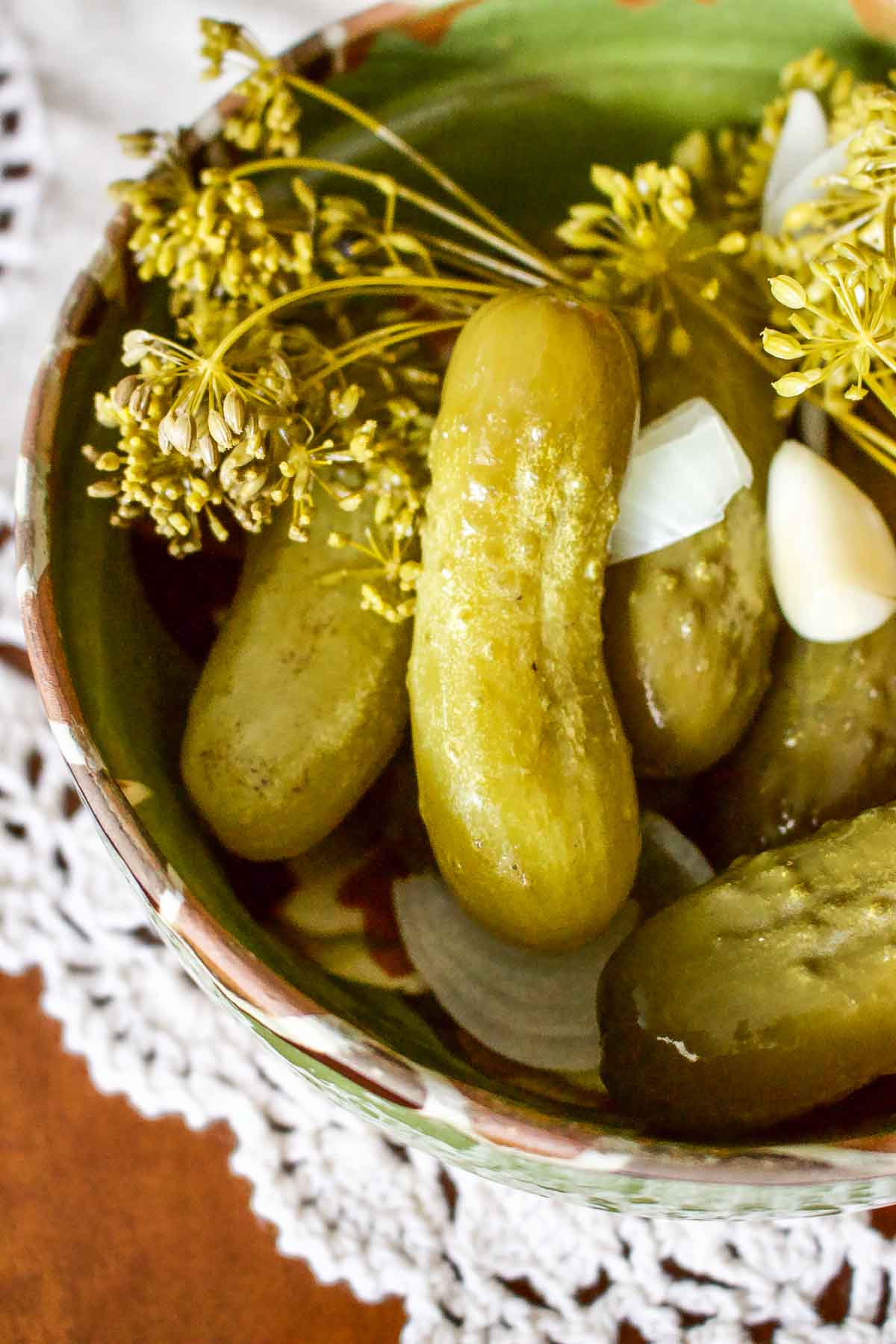
Jump to:
- Best Lacto-Fermented Pickles
- How Eastern Europeans preserve the vegetables from their gardens before the winter comes
- Ingredients needed
- How to quickly lacto-ferment cucumbers in the summer
- What happened during these six days while the cucumbers were fermenting
- Recipe Faqs
- More Recipes To Love
- 📖 Recipe
- 💬 Comments
Best Lacto-Fermented Pickles
I am sitting here looking through my canning recipes as I need to flood you with some more ideas before the winter comes. I just made these lacto-fermented pickles using an ancient and easy method of preserving cucumbers in salt and water.
You see, cucumbers pickled this way are not a new trend. People have preserved vegetables in brine for thousands of years. If you know how to prepare fermented foods, they are delicious and good for your digestive system. Our ancestors used to eat a lot of this stuff. They knew all about it, and every culture worldwide has some lacto-fermented food in their cuisine.
These dill pickles get their characteristic tangy flavor through old-fashioned fermentation. Salt, water, dill, garlic, and spices are combined in jars filled with small cucumbers and left in a warm place for a few days.
The friendly bacteria take over, and while they eat the natural sugars in the cucumbers, they produce lactic acid, which helps the cucumbers become sour and delicious.
The recipe is Romanian, but all Eastern European countries pickle cucumbers or other vegetables almost the same way. Europeans brought the recipes to America when they migrated, and we can be forever grateful and thank them for this treasure.
While pickles in vinegar are very popular in America, cucumbers in brine are better for your health.
Lacto-fermentation, both pickles and juice, is full of gut-health-promoting probiotics, and homemade pickles are way better than any product you might buy in the stores.
I visit Trader Joe's weekly because I love the store. It is close to my house and easy to get there. They have jars of lacto-fermented pickles and also sauerkraut in the refrigerated area, and I buy them once in a while.
However, after making these pickles at home, I have to tell you that they are far superior to the store ones. It might be the love I put in them, for sure. Just look at them. How can you not fall in love with these beauties?

I saw two different types of pickled cucumbers in brine in Romanian cuisine. One is the summer pickling, which we are making today.
The other type is pickling cucumbers and other vegetables in brine for the winter. Both methods are pretty similar.
However, the summer cucumbers are lacto-fermenting outside, in the sun, which takes only a few days, while the ones preserved for the winter will ferment slower in a cool place.
How Eastern Europeans preserve the vegetables from their gardens before the winter comes
The process of lacto-fermentation is mostly science. I am sure you are probably familiar with sauerkraut or kimchi. Basically, using this method, you can lacto-ferment any vegetable in the garden.
Before you start asking questions, I will tell you what Romanians do in late September-October before the cold season comes.
They use barrels of different sizes and gather together everything leftover in the garden: cucumbers, green tomatoes, carrots, cauliflower, peppers, baby watermelons, celeriac, horseradish (very important), garlic, onions, small cabbage, apples, quince, etc.
Everything gets cleaned up and thrown in that barrel. Salt, water, and spices join the party over the vegetables, and the waiting time begins.
As there are so many vegetables in the "pool," the pickling might take a few weeks, as each vegetable takes its own time. It is also cooler outside, so the vegetables ferment slower.
The pickles are submerged in brine the whole winter, and barrels are kept in a cool place so the fermentation slows down. The pickles are served with roasted pork, chicken, potatoes, beans, soups, and stews.
Ingredients needed
- Small cucumbers: You will need small, dark green, firm cucumbers that are slightly underripe. Big cucumbers will not pickle properly, and you might end up with mushy ones. Not bad, but meh.
- Onions- sliced thinly
- Garlic cloves
- A bunch of bloomed dill
- Thyme (optional)
- Mustard seeds
- Pickling spices
- Pickling salt (no iodine)- Do not use regular salt unless it is iodine-free (iodine is not suitable for fermentation)
- Nonchlorinated water
- Jars (the size of the jar doesn't matter as long as the cucumbers have enough space inside to stay submerged in the brine. I used quart, half-gallon, and gallon sizes with success)


How to quickly lacto-ferment cucumbers in the summer
Step 1. Gather the ingredients together. If the cucumbers have spikes, brush them gently to get rid of them. Wash them in cold water. Trim off the ends as they harbor an enzyme that can make the pickles too soft.
Step 2. Prepare the brine. In a big pot, place water and salt and bring to a boil. Make sure the salt dissolves completely in the water. When the water starts boiling, remove it from the heat and allow it to cool.
Step 3. Clean the jars. Meanwhile, make sure the jars are sparkly clean.
Step 4. Add spices and herbs to the jar. Place dill on the bottom of each jar. Add onion slices, a few garlic cloves, mustard seeds, thyme, and pickling spices. Start adding cucumbers, leaving at least 2 inches of headspace from the rim of the jar. Add more garlic cloves and onions. Place a bunch of dill over the cucumbers.
Step 5. Pour the brine over the cucumbers and make sure everything is submerged in it. I also cut the ends of the dill and added them as little sticks on top of the jar to push the vegetables inside the brine.


Step 6. Cover the jars. There are different methods to cover the jars. I used a simple one: little plates that I placed on top of the jars. Some people cover the jars with the lids, but a small plate worked perfectly for me. During the earliest stages of fermentation, carbon dioxide is released.
If you cover the jar with a lid, make sure to do the following: check your jars once or twice daily to see if the lids are building up pressure. Very quickly and carefully “burp” your jar by slightly unscrewing the lid, allowing a bit of gas to escape, and screwing it back on quickly.
As I specified before, I did not need to do that, as I placed a small plate over the jar opening.
I put the jars on a baking tray and placed the tray outside on the balcony. Romanians place the jars in the sun, but I don't have much sun on my balcony. For that matter, the fermentation happened a little bit slower in about six days. If you place the jars exposed to the sun, they will ferment much faster.
I suggest you taste the cucumbers after three days and see if they are salty and sour. If not, let them be for another day or two until they are ready.
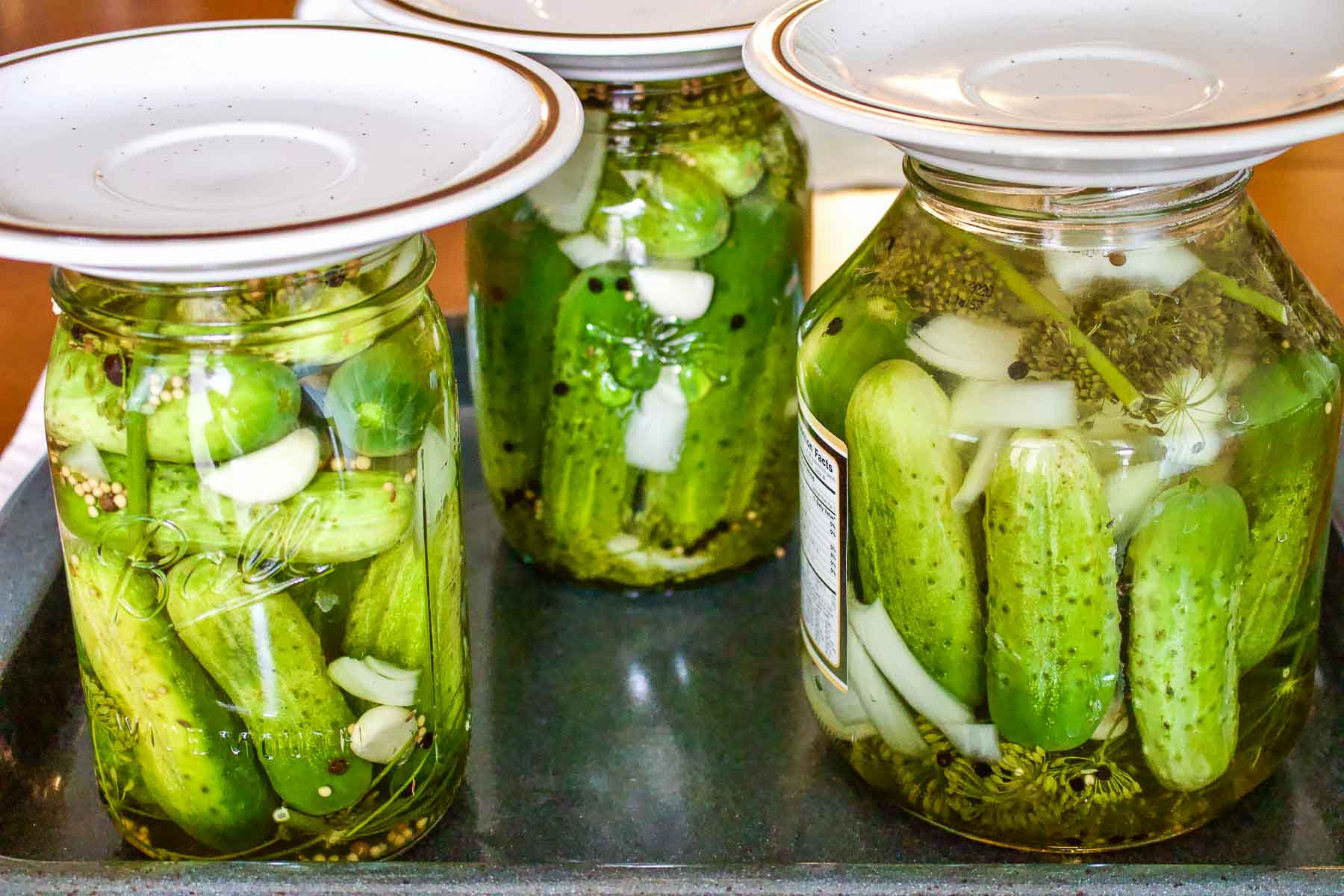
What happened during these six days while the cucumbers were fermenting

- Day 2. The liquid started to bubble and became a little bit cloudy. This is a good sign as it means that the lactic acid fermentation process has started. The bacteria feast on the vegetables, and that creates gases that are released.

2. Day 4. The liquid is cloudier, but it smells pleasant and vinegary. One taste of cucumber made me decide that the batch needed to sit for another day or two.
Once a day, I removed the plate and smelled the liquid. It should be a sour, vinegary aroma combined with the spices, a quite pleasant smell. On day 6, the cucumbers were ready for refrigeration.

This is how the pickles looked inside. My lacto-fermented pickles turned out slightly sour, super crunchy, and deliciously tangy.

So, are you going to make a batch of pickles this way? Looking at that list of things to do can be intimidating, but I promise you that once you do this a few times and understand the process, it is the easiest way to make delicious and healthy pickles.
Just make sure you consume these pickles in two weeks.
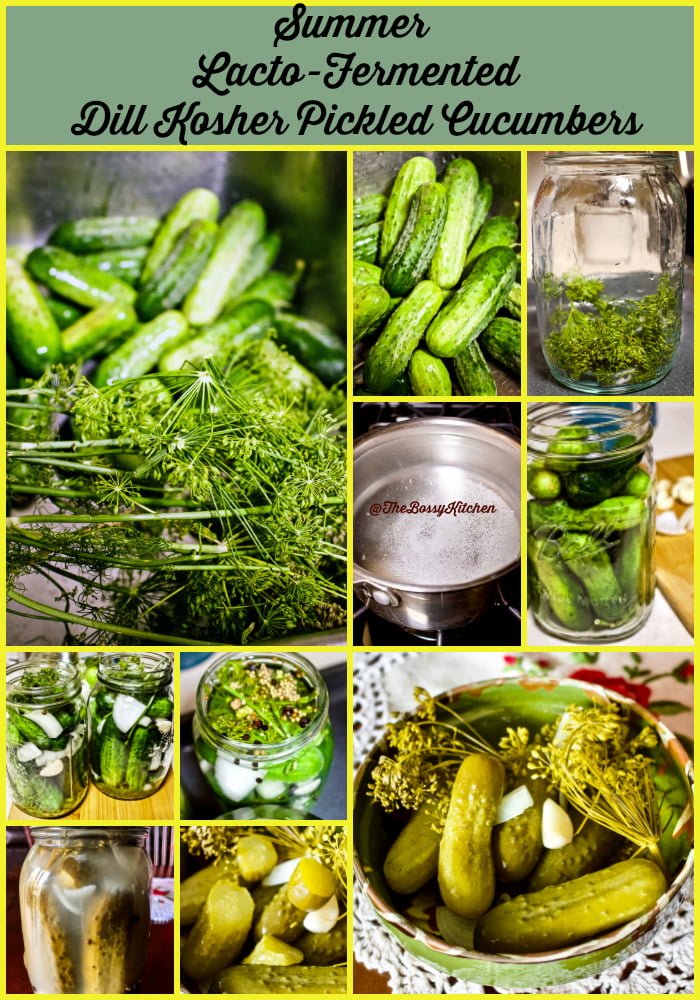
Recipe Faqs
No, you cannot. These are quickly fermented vegetables, not canned. Lacto-fermentation is a common and traditional form of pickling vegetables, but it is not the same as canning, and it is not used for long-term preservation.
The taste will change over time as the fermentation continues, even if you place the pickles in a cold place.
Fermented foods are consumed as soon as they reach the desired level of fermentation and are finished quickly before the flavors change too much. Canning involves sterilization as the product is designed to last often six months or more.
Yes, you can try green tomatoes, carrots, cauliflower, peppers, baby watermelons, celeriac, cabbage, apples, quince, etc.
While I am sure there might be other vegetables that can be pickled this way, I recommend you look for recipes that teach you how to preserve that specific fruit or vegetable you want to experiment with.
It is better because it is healthier. I am not a nutritionist, and I am not trying to make health claims, but this is a known fact. The lactic acid in the jars is a natural preservative that inhibits the growth of harmful bacteria.
Lacto-fermentation also increases or preserves the vitamin and enzyme levels of the fermented food. In addition, lactobacillus organisms are the heroes when it comes to good bacteria in your gut and probiotics.
You might get anxious if your fermented pickles do not look like the home-canned pickles you are used to. Here’s what to expect:
a. Cloudy brine, often getting cloudier as time progresses.
b. Fizziness! Fizzy brine is totally normal and just a sign that things are working as they should.
c. Liquid leaking out of the jar. Again, it's absolutely normal. However, you can sometimes avoid it by ensuring you don’t add too much brine to your jars. This is the reason I placed my jars on a baking tray, just to make sure that I don't make a mess.
d. Bubbles equals happy pickles.
e. Pleasant sour taste. Fermented pickles have a slightly different tang than vinegar pickles.
More Recipes To Love
- Mustard Pickled Vegetables- A Winter Delight
- Romanian vegetable spread-Zacusca
- How To Salt Preserve Herbs For Winter
📖 Recipe

Lacto-Fermented Dill Pickles
Ingredients
- 3 pounds small cucumbers
- salt free of iodine like pickling salt
- water- chlorine free
- 7-8 garlic cloves if too big slice them in half
- 1 medium white onion chopped into small pieces
- a bunch of dill blossoms
- 1-2 teaspoons dried thyme
- 2-3 tablespoons pickling spices
- 2 tablespoons mustard seeds
- Jars
Instructions
- Gather the ingredients together. Use small cucumbers that are slightly under-ripe, dark green and firm. If they have spikes, brush them gently to get rid of them. Trim off the ends.
- Prepare the brine. In a big pot, place water and salt and bring to a boil. Rule: For each quart of water, you need 2 tablespoons of salt. Make sure the salt dissolves completely in the water. When the water starts boiling, remove the pot from the heat and let it cool.
- Place dill on the bottom of each jar. Add some pieces of onion, a few garlic cloves, a few mustard seeds, thyme and pickling spices.
- Start adding cucumbers, leaving at least 2 inches of headspace from the rim of the jar. Add more garlic cloves and onions. Place a bunch of dill over the cucumbers.
- Pour the brine over the cucumbers and make sure everything is submerged in it.
- Cut the ends of the dill blossoms and use them as little sticks on top of the jar, to keep the vegetables inside the brine.
- Cover the jars with a little plate and place them outside in warm temperatures.
- During the earliest stages of fermentation carbon dioxide is released. You will notice the liquid will start bubbling, which is a good sign. In case you seal the jars with the lid, check them once or twice a day to see if the lids are building up pressure. Very quickly and carefully “burp” your jar by slightly unscrewing the lid, allowing a bit of gas to escape, and screwing it back on quickly. If you just cover the jar with a plate, you don't need to do that, just make sure nothing gets inside the jar.
- You will notice that the liquid becomes cloudier, this is a sign of lactic acid forming. This is very normal. Allow the fermentation to continue for a few days. My batch was ready to refrigerate after 6 days, but keep an eye on the jars and taste the cucumbers after the 3rd day if it is very warm where the jars are sitting. They might get sour faster.
- As soon as you are pleased with the texture and taste of the cucumbers, place the jars inside the refrigerator and consume them in the next two weeks.
- Serve them with grilled or roasted meats, sausages, burgers, potatoes, stews, soups etc.

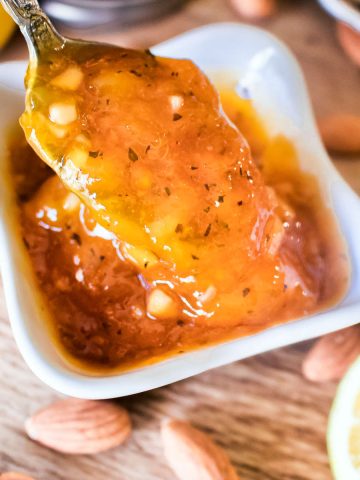

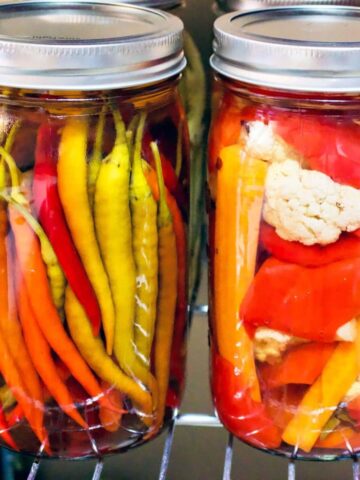
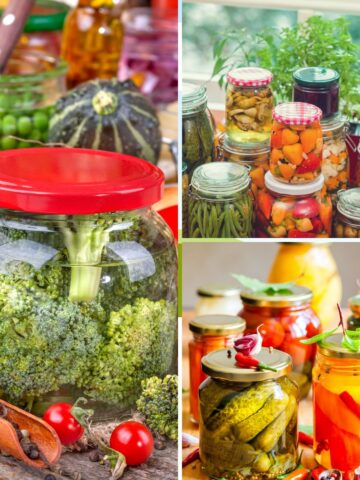
Jimmy Pender says
Is it possible to can for longer preservation?
Kirsten Moreman says
Thank you for sharing. I followed your recipe but I’m a little nervous it may be too hot in my region (Texas). They are outside in the direct sun. It’s rather hot here. I got pretty good bubbles after 24hrs. Today is day 3. I’m going to move them out fo the sun but I think I may need to toss this batch. I’m seeing some articles that say it isn’t save above 73 degrees 😬
The Bossy Kitchen says
Hi. Taste the liquid. Does it smell nice? You should not have an unpleasant odor coming from the jar. How are the cucumbers? If the liquid has any foam on top, try to remove it. Because of the heat, you might need less days for pickling and there is nothing wrong with that. As long as they are not spoiled, they are good to eat. Also, make sure you put them in the refrigerator when you finish the fermentation process.
Ingrid Douglas says
Very interesting that you say outside in the sun. I had no idea! I've always seen cool, dark places as sun kills the lactobacilli strains that are needed for fermentation.
Gabriela says
This is a summer recipe and the pickling happens fast. We do not keep those for the winter. Yes, if you want them for winter, then they need to go slow, in a dark, cool, environment.
Carolyn Williams says
Hi, I made these delicious pickles before and they came out perfect.
But this time I had a really disappointing issue, when I checked the cucumber/pickles they were mushy and rotten, they got so soft they were collapsing to the touch. I thought you might be able to help me because I would like to do them again but it was a lot of work down the drain and I wouldn't want it to happen again.
thanks so much for any advice
Carolyn
The Bossy Kitchen says
Hi Carolyn, After how many days you checked on them? Were they covered completely, did you burb them every single day? Did you remove any foam forming on the surface? Was it very, very hot where you put them? Did you use cucumbers from the garden or the grocery store? As you don't tell me exactly what happened, I have a hard time advising you what to do with the next batch. I had mushy canned vegetables before using grocery store stuff that was not organic. Pesticides are not good in the jars. However, there are different things that could go wrong, so I need details to troubleshoot the issue.
VICTORIA Holm says
Can I pressure can or hot bath these to make them last over the winter?
The Bossy Kitchen says
No, you cannot. If you pressure can or hot bath them, you destroy the good bacteria that is in the brine. If you need to can for winter, try this recipe: https://www.thebossykitchen.com/pickled-cucumbers-in-vinegar-easy-recipe/.
Janice S says
Those look delicious! My husband is Hungarian and I’ve been making summer pickles every year. I use 1-2 fresh grape leaf per jar just so the cucumbers do not turn soft or mushy. I tried without the grape leaf one day but the cucumbers did not stay crunchy. Also, I add a slice of baguette or Italian bread.
VICTORIA Holm says
Hello, I enjoy your canning advice. I've made 2 batches of fermented Pickles and they are delish!
You state that they should be consumed before 2 weeks but I also just read this for the winter pickles ...."The pickles are submerged in brine the whole entire winter and barrels are kept in a cool place, so the fermentation slows down. The pickles are served with roasted pork, chicken, potatoes, beans, soups and stews. "
So, if I have mine in the fridge to stop fermentation is it still 2 weeks to consume the pickles?
I want to make sure my family is ok if they eat them too...
I remember my mom making a cauliflower, pepper, pearl onion and other items in a fermentation brine for lunch on the weekends.
Can you share that recipe? If yes, can you share the link?
Thanks!
Have a great day!
Vicki
The Bossy Kitchen says
Hi Victoria,
I do not have a recipe for the cucumbers in brine for winter on the website. The process is more complicated, and most people won't bother following the process. The brine needs to be processed differently so the vegetables survive in the jars for the entire winter. People in the villages who brine vegetables in barrels need to roll the barrels and air the brine, so it stays fresh and delicious. As I said, it is a different process.
This recipe of cucumbers in brine for summer is an easy recipe that anybody can do. I will say 2 weeks is a good time frame to keep the pickles in the fridge, but you will know if the brine or the cucumbers are going bad. The brine might start getting moldy on top, the cucumbers might get mushy and unpleasant to eat. However, my cucumbers were fine even a month after I put them in the fridge. If they smell and taste good, they are good to eat. The brine is very healthy for your gut and delicious. They don't spoil very easily.
If you want to pickle cucumbers for winter, I would suggest this recipe instead: https://www.thebossykitchen.com/pickled-cucumbers-in-vinegar-easy-recipe/
I hope this helps.
The Bossy Kitchen says
Also, I do not have a recipe for cauliflower, pepper, pearl onion, etc., on the site, but I am sure you can find some similar recipes online though.
VICTORIA Holm says
One more question...
My dill didn't grow well this year. I used what I had and had to purchase fresh dill at the grocery... They don't have tops though. WIll this work over the winter if I choose to ferment monthly, maybe to keep a jar of fresh fermented veggies in the fridge?
thank
vicki
The Bossy Kitchen says
Yes, you can use fresh dill, but you can also use dried.
Jill says
Awesome post - very well done!! Question: Do we need to keep the seeds and other spices submerged under the brine as well, or are they not as subject to mold since they are dried? Thanks!!
The Bossy Kitchen says
Just add them to the salted water and they will do their job, they don't get moldy.
Jill says
@The Bossy Kitchen, Yay! Thanks so much! Keep up the good work!!!!
Sula says
Too much writting.
Wish you would just get to recipe and simplify!!
The Bossy Kitchen says
The most valuable information is inside the article, as it explains to you step by step what to expect during the fermentation process. If scrolling is a problem, there is also a "Jump to Recipe" button at the beginning of the article that will take you straight to the recipe.